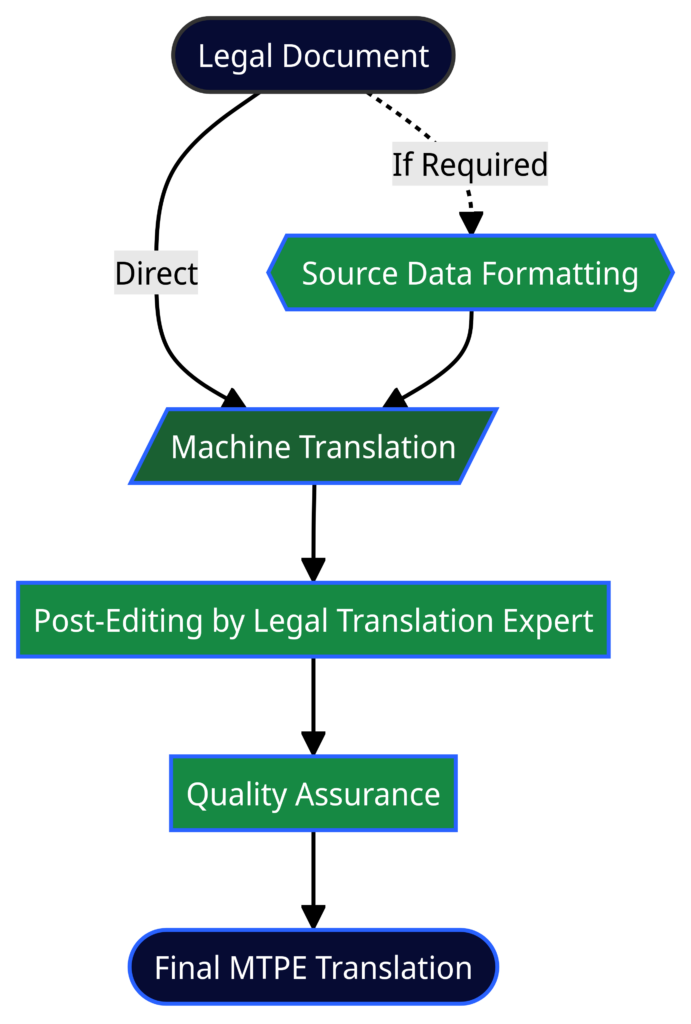Enhancing Legal Translation Accuracy: The Role of Machine Translation and Post-Editing
March 18, 2024
The legal industry faces an unprecedented transformation driven by integrating artificial intelligence (AI) and automation in translation processes. As the demand for accurate and cost-efficient legal translation services grows, the reliance on machine translation (MT) to help flag relevant documents and understand basic content has been adopted by a vast majority. For translations being relied on in external settings, machine translation followed by meticulous post-editing has emerged as a pivotal solution. When it’s the right fit, this advanced approach guarantees faster and less expensive translation of legal documents than fully human work.
Machine Translation in Legal Contexts
Machine translation, powered by sophisticated AI algorithms, has significantly evolved from basic direct translation to more complex, context-aware outputs. Legal documents contain nuanced phrases and terms that are challenging for traditional MT systems. However, the latest AI models are trained on vast legal corpora, enabling them to understand and translate the intricate language of legal documents with higher accuracy.
The primary advantage of machine translation in legal contexts is its ability to process large volumes of text swiftly and at a fraction of the cost of human translation, which, not too long ago, was the only option available. This rapid turnaround is invaluable for legal professionals for whom time is often of the essence. Additionally, AI-driven MT reduces the initial translation costs, making legal translation services more accessible to a broader audience. Keeping costs under control is especially important when cases increasingly produce more documentation in our vast digital world.
Post-Editing: Ensuring Precision and Consistency
While machine translation provides a robust foundation, human expertise in the post-editing phase is indispensable. Legal translators review the machine-generated text to correct inaccuracies, ensuring the final translation is accurate, fluent, consistent, grammatically correct, and adapted to context and cultural nuances. This hybrid model combines the speed of AI with the discernment of human experts, delivering fast and reliable translations.
Effective post-editing involves more than mere proofreading. Legal translators must deeply understand legal terminology, cultural nuances, and the specific jurisdiction requirements they are translating. A standardized glossary and style guide can enhance translation consistency, improving the quality and reliability of legal documents.
Putting aside large-scale projects, MT with human post-editing is becoming a better fit for legal documents with standardized language, repetitive clauses, and recognizable patterns such as contracts, policies, patents, manuals, and regulatory material.
Integrating MT and Post-Editing into Legal Translation Workflows
Incorporating a workflow that effortlessly combines machine translation and post-editing expedites the translation cycle and guarantees that the translations adhere to the rigorous standards demanded by the legal industry.
The following diagram illustrates the process from the original legal document through machine translation, human post-editing, and quality assurance to the final, accurately translated legal document.

Combining machine translation and post-editing has brought about significant progress in legal translation. By utilizing the speed and efficiency of AI-powered tools and the meticulous attention to detail provided by human experts, providers of legal translation solutions can offer precise, reliable, and cost-effective translations. The expectation is that legal translation technology advancements can enhance accuracy and efficiency, transforming the standards of legal translation services.